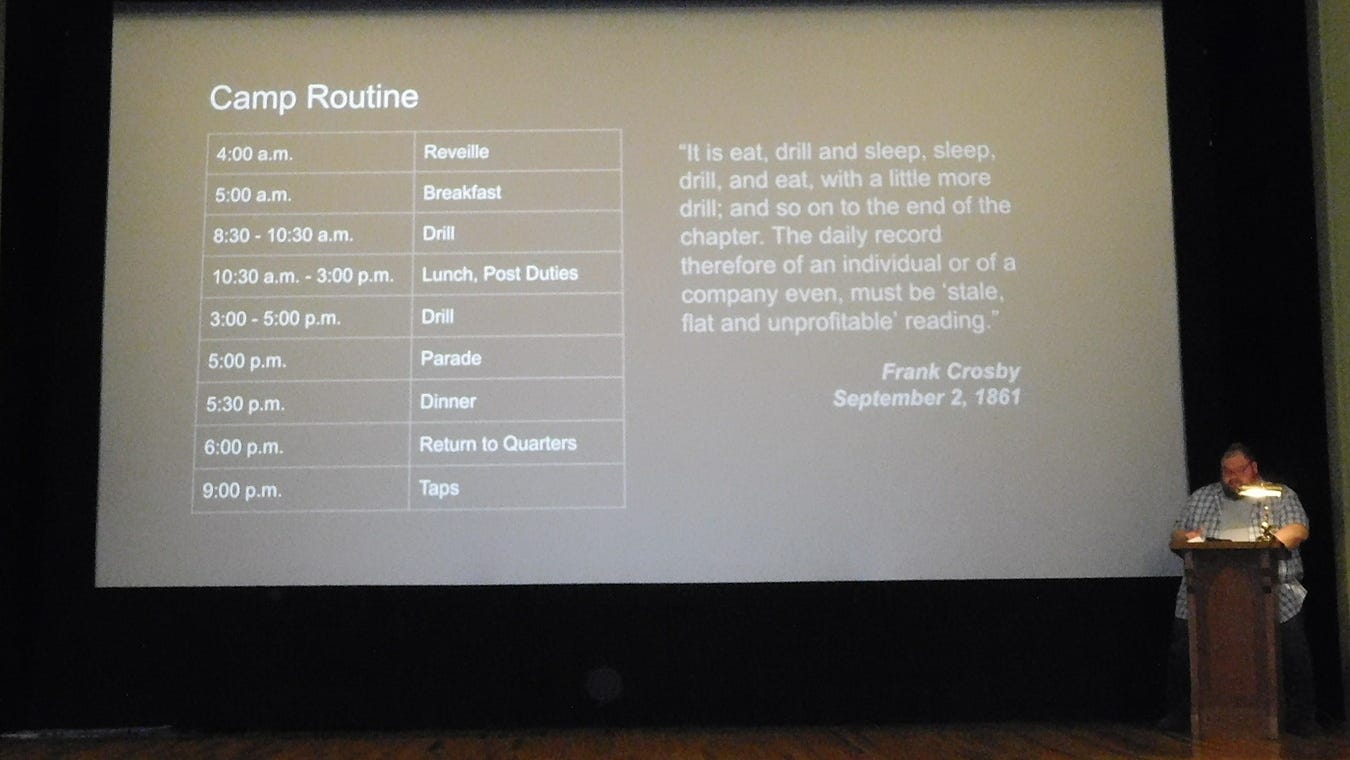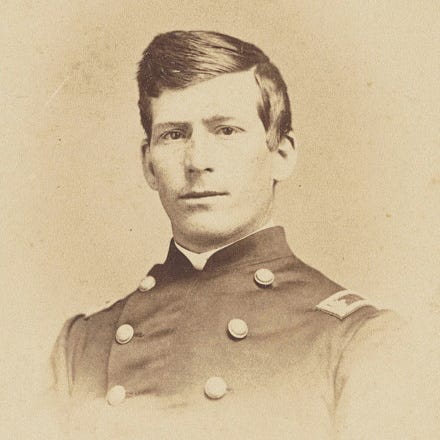The Tama County Rifles in the Civil War
Company C of the 10th Iowa Infantry was at many key battles

TOLEDO — Iowa was their adopted state. For some, the United States was their adopted country. All answered the call in April 1861 when President Abraham Lincoln sought soldiers to preserve the Union.
The Civil War stories of Company C of the 10th Iowa Infantry, also known as the “Tama County Rifles,” were revisited April 10 at the Wieting Theatre in Toledo. Jason Staker gave a presentation to about 40 people, a few of whom were descendants of those soldiers.
The Rifles traveled through every Confederate state except Florida and Texas. They were part of Gen. Ulysses S. Grant’s siege of Vicksburg and participated in Gen. William T. Sherman’s March to the Sea.
Men of many professions left their wives and children to become soldiers. The average age was 26. Aaron Tice lied about his age and got in as a 16-year-old. The oldest allowed in was Casper Meisner, 49. The Tama County Board of Supervisors voted money to dress the company and pay family stipends.
Throughout the war, the most deadly opponent would not be the Confederate Army, but disease. Timothy Cook, 18, was too sick to leave Toledo and died Aug. 22, 1861. He was buried in a uniform that had never been worn in battle.
Capt. Albert Stoddard led Company C, and Col. Nicholas Perczel, a hero of the Hungarian Revolution, was in charge of the 10th Iowa. The second half of 1861 was spent traveling south, drilling, and occasionally skirmishing with guerrilla forces in southeast Missouri.

Spring 1862 found the Rifles either on the periphery of battles — New Madrid, Island No. 10, Fort Pillow, and First Corinth — or fighting the twin forces of disease and weather. They made coffee from puddle water. Boats were so full they couldn’t take shelter in the rain. Typhoid swept through in May. George Tompkins wrote to his father that he was severely ill, but the letter would not get back to Toledo until after his death.
Battles in Mississippi
The Battle of Iuka on Sept. 19, 1862, put the 10th Iowa in the heat of combat. The northeasternmost town in Mississippi was a vital rail station. Thomas Free sent a recount to the Iowa Transcript in Toledo. “Every conceivable form of mutilation could be witnessed. … All was confusion, tumult, rage.” It was a Union victory, but the Confederates withdrew overnight. Free had harsh words for the Union’s commanding officer.
Grant’s Blunder.
There he lay within sound of musketry and almost in sight of the field, while we engaged them on our front; instead of attacking their rear, with blind stupidity no effort was made, and when the day was lost they retreated towards Tupelo 40 miles distant; otherwise they would without a doubt have been bagged and the entire force taken; so much for generalship.
— Iowa Transcript, Oct. 16, 1862
What Free did not know was that a phenomenon called “acoustic shadow” had prevented Grant from being able to hear the sounds of battle entirely.
The battle left such an imprint back home that when railroad tracks reached a point two miles south of Toledo in November 1862, the new station was named Iuka. That lasted about four years until the name was changed to Tama City.
At the Second Battle of Corinth on Oct. 3-4, 1862, Sgt. John Stebbing was the Rifles’ first battlefield death. One soldier was saved through remarkable luck: He was carrying the regimental flag and struck by a minie ball right in the metal flag holder.
After an aborted attempt to approach Vicksburg from the north, the 10th Iowa joined Grant’s successful march to Jackson from the southwest. Champion Hill was halfway between Jackson and Vicksburg. The battle there on May 16, 1863, was the single costliest day for the Tama County Rifles of the war. Of 36 soldiers, 7 were killed in action and 12 were wounded. The 10th Iowa then served as a rear guard in the Siege of Vicksburg, and that city surrendered July 4. News reached Toledo four days later.
The Rifles’ Mississippi River adventures were over. It was on to Tennessee.
Marching through Georgia (and other states)
After a summer in Vicksburg and a month of marching, the 10th Iowa made it to Chattanooga and was pressed into battle days after arriving. On Nov. 10, 1863, near the north end of the battlefield, Sherman ordered an attack on Tunnel Hill at Missionary Ridge. Union soldiers faced a Rebel line 10 deep. The Rifles had one casualty, 1st Lt. George H. Conant, who is buried near the battlefield. Five were wounded, including one saved when the bullet struck his glasses case.
During the first part of 1864 in Huntsville, Alabama, the soldiers had to make a decision about re-enlisting. Many did so, and the 10th Iowa was declared a veteran regiment March 20, 1864. That summer, the Rifles returned home on furlough to Tama County.
By the time the men went to Georgia, Atlanta was near surrender, and they spent a few months on railroad duty and uneventful pursuits. In November, the 10th Iowa joined the Army of the Tennessee on Sherman’s March to the Sea, a campaign designed to demoralize and humiliate the South. They spent Christmas in Savannah.
The regiment stayed with Sherman through the Carolinas. Their last battle was Bentonville, North Carolina, on March 19-21, 1865, the largest in that state. On April 26, Confederate Gen. Joseph E. Johnston surrendered to Sherman near Durham. On May 25, the 10th Iowa paraded in the Grand Review of the Armies in Washington, D.C. They were ordered to Louisville, then to Little Rock, and finally mustered out on Aug. 15.
After the war

Eighteen members of the Tama County Rifles were killed on the battlefield, among the 107 men from Tama County overall counted as honored dead.
Jacob Reinig built a home near Toledo and raised 11 children with his wife Eliza. Frank Crosby oversaw mining operations across the country and then switched to geology, acting as a collector for the Smithsonian in Europe and Asia.
Thomas Free, who wrote many war dispatches to the Iowa Transcript, became the first Tama County auditor in 1869. He went to be an agent for the Sac and Fox Tribe in Dakota Territory but died in the Yankton Insane Asylum in 1886. Capt. Albert Stoddard, whose service ended in October 1864, dealt with “demons” after the war.
Aaron Tice, the youngest member of the Tama County Rifles, was the second to last to die, at the age of 92 in Wisconsin in 1937. Frank Hulka, 97, who had joined in 1864, died in Farnhamville on Feb. 2, 1938.
Information from the 1883 History of Tama County, Iowa, and Iowa Transcript archives was used to supplement Staker’s presentation for this story.
My other work can be found on my website, Iowa Highway Ends, and its blog.
I am proud to be part of the Iowa Writers’ Collaborative. If you’re interested in commentary by some of Iowa’s best writers, please follow your choice of Collaborative members:




👍an amazing story!
My uncle attended iowa state back in the 70s and took some course on the history of Iowa. He was an engineering student so this may have been mandatory. He had zero interest in the class and did the bare minimum the whole semester.
They had some big term paper in lieu of a final exam. A day or two before the due date he concocted a magnificent yarn about some hill in his grandfather's hometown where volunteer regiments in the civil war gathered and paraded for the locals before marching off to war. Complete fabrication.
A couple weeks into winter break he gets the report card -- he passed. But when he went to the prof's office to collect his own from the stack of graded papers, it was missing. Knowing he had gotten away with murder he most definitely did not inquire with the prof about getting his paper back.